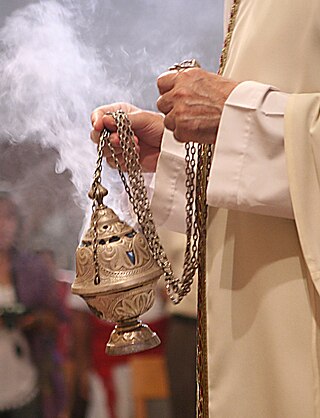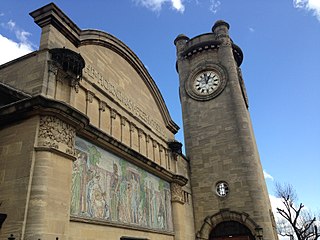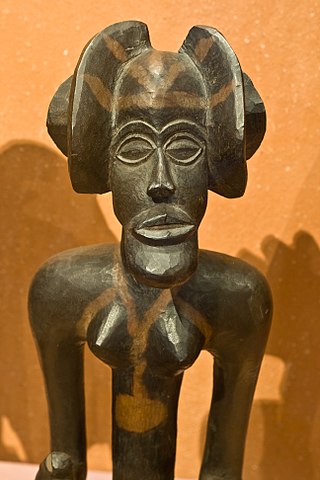
Ikupasuy are wooden, carved ceremonial sticks used by Ainu men when making offerings to spirits.

Ikupasuy are wooden, carved ceremonial sticks used by Ainu men when making offerings to spirits.
The central section of an ikupasuy is decorated, featuring animals, floral motives as well as abstract designs. The ends of an ikupasuy bear designs that represent the patriarchal lineage of the owner. The Ainu believe that the designs on the ends of the ikupasuy help the spirits in identifying the person who made the offering. The underside of the ikupasuy may on some occasions be carved with various symbols called shiroshi. A common shiroshi is symbol representing the killer whale. The pointed end of the ikupasuy is known as the 'tongue'. [1] The libation process is performed when the ikupasuy's ‘tongue' placed into a lacquerware cup or saucer, containing millet beer or sake. Drops of the liquid then fall upon the venerated object. [2] The Ainu limited their representation of animals and to the ikupasuy. Ainu men occasionally used the ikupasuy as a mean to lift their moustaches, leading non Ainu observers of this habit to call them moustache lifters. [3] Another name is "libation sticks". [4]

The Ainu are an ethnic group of related indigenous peoples native to northern Japan, including Hokkaido and Northeast Honshu, as well as the land surrounding the Sea of Okhotsk, such as Sakhalin, the Kuril Islands, the Kamchatka Peninsula, and the Khabarovsk Krai; they have occupied these areas known to them as "Ainu Mosir", since before the arrival of the modern Japanese and Russians. These regions are often referred to as Ezo (蝦夷) in historical Japanese texts.

A ceremonial mace is a highly ornamented staff of metal or wood, carried before a sovereign or other high officials in civic ceremonies by a mace-bearer, intended to represent the official's authority. The mace, as used today, derives from the original mace used as a weapon. Processions often feature maces, as on parliamentary or formal academic occasions.

A censer, incense burner, perfume burner or pastille burner is a vessel made for burning incense or perfume in some solid form. They vary greatly in size, form, and material of construction, and have been in use since ancient times throughout the world. They may consist of simple earthenware bowls or fire pots to intricately carved silver or gold vessels, small table top objects a few centimetres tall to as many as several metres high. Many designs use openwork to allow a flow of air. In many cultures, burning incense has spiritual and religious connotations, and this influences the design and decoration of the censer.

A libation is a ritual pouring of a liquid as an offering to a deity or spirit, or in memory of the dead. It was common in many religions of antiquity and continues to be offered in cultures today.

African art describes the modern and historical paintings, sculptures, installations, and other visual culture from native or indigenous Africans and the African continent. The definition may also include the art of the African diasporas, such as: African-American, Caribbean or art in South American societies inspired by African traditions. Despite this diversity, there are unifying artistic themes present when considering the totality of the visual culture from the continent of Africa.

The Horniman Museum and Gardens is a museum in Forest Hill, London, England. Commissioned in 1898, it opened in 1901 and was designed by Charles Harrison Townsend in the Modern Style. It has displays of anthropology, natural history and musical instruments, and is known for its large collection of taxidermied animals. The building is Grade II* listed.

Ainu music is the musical tradition of the Ainu people of northern Japan. Ainu people have no indigenous system of writing, and so have traditionally inherited the folklore and the laws of their culture orally, often through music.

A spirit house is a shrine to the protective spirit of a place that is found in the Southeast Asian countries of Burma, Cambodia, Laos, Thailand, Malaysia, Indonesia, Vietnam and the Philippines. They are normally in the form of small roofed structure mounted on a pillar or a dais, and can range in size from small platforms to houses large enough for people to enter. Spirit houses are intended to provide a shelter for spirits that could cause problems for the people if not appeased. They often include images or carved statues of people and animals. Votive offerings are left at them to propitiate the spirits; more elaborate installations include an altar for this purpose.

A Bisj, Mbis or Bis pole is a ritual artifact created and used by the Asmat people of South-western New Guinea, Indonesia. They are also common in New Zealand, Vanuatu.

The Chokwe people, known by many other names, are a Bantu ethnic group of Central and Southern Africa. They are found primarily in Angola, southwestern parts of the Democratic Republic of the Congo, and northwestern parts of Zambia.

Ainu cuisine is the cuisine of the ethnic Ainu in Japan and Russia. The cuisine differs markedly from that of the majority Yamato people of Japan. Raw meat like sashimi, for example, is rarely served in Ainu cuisine, which instead uses methods such as boiling, roasting and curing to prepare meat. Also unlike Japanese cuisine, traditional Ainu cuisine did not use miso, soy sauce, or sugar, though these seasonings make an appearance in modern Ainu cuisine. The island of Hokkaidō in northern Japan is where most Ainu live today; however, they once inhabited most of the Kuril islands, the southern half of Sakhalin island, and parts of northern Honshū Island.

Apotropaic magic or protective magic is a type of magic intended to turn away harm or evil influences, as in deflecting misfortune or averting the evil eye. Apotropaic observances may also be practiced out of superstition or out of tradition, as in good luck charms, amulets, or gestures such as crossed fingers or knocking on wood. Many different objects and charms were used for protection throughout history.

Australian Aboriginal artefacts include a variety of cultural artefacts used by Aboriginal Australians. Most Aboriginal artefacts were multi-purpose and could be used for a variety of different occupations. Spears, clubs, boomerangs and shields were used generally as weapons for hunting and in warfare. Watercraft technology artefacts in the form of dugout and bark canoes were used for transport and for fishing. Stone artefacts include cutting tools and grinding stones to hunt and make food. Coolamons and carriers such as dillybags, allowed Aboriginal peoples to carry water, food and cradle babies. Message sticks were used for communication, and ornamental artefacts for decorative and ceremonial purposes. Aboriginal children’s toys were used to both entertain and educate.
A kamuy is a spiritual or divine being in Ainu mythology, a term denoting a supernatural entity composed of or possessing spiritual energy.

Hopi katsina figures, also known as kachina dolls, are figures carved, typically from cottonwood root, by Hopi people to instruct young girls and new brides about katsinas or katsinam, the immortal beings that bring rain, control other aspects of the natural world and society, and act as messengers between humans and the spirit world.

Coast Salish art is an art unique to the Pacific Northwest Coast among the Coast Salish peoples. Coast Salish are peoples from the Pacific Northwest Coast made up of many different languages and cultural characteristics. Coast Salish territory covers the coast of British Columbia and Washington state. Within traditional Coast Salish art there are two major forms; the flat design and carving, and basketry and weaving. In historical times these were delineated among male and female roles in the community with men made "figurative pieces, such as sculptures and paintings that depicts crest, shamanic beings, and spirits, whereas women produced baskets and textiles, most often decorated with abstract designs."
Wood carving is a common art form in the Cook Islands. Sculpture in stone is much rarer although there are some excellent carvings in basalt by Mike Tavioni. The proximity of islands in the southern group helped produce a homogeneous style of carving but which had special developments in each island. Rarotonga is known for its fisherman's gods and staff-gods, Atiu for its wooden seats, Mitiaro, Mauke and Atiu for mace and slab gods and Mangaia for its ceremonial adzes. Most of the original wood carvings were either spirited away by early European collectors or were burned in large numbers by missionary zealots.
Inau or Inaw is an Ainu term for a ritual wood-shaving stick used in Ainu prayers to the spiritual world. They were used in most Ainu religious rituals, and were also frequently made to request assistance for hunting and childbirth. Some can be used multiple times, while others are destroyed immediately after one use. Their size and the direction in which they are shaved depends on which kamuy it is offered to and what is being requested.

Trinidad Orisha, also known as Orisha religion and Shango, is a syncretic religion in Trinidad and Tobago and the Caribbean, originally from West Africa. Trinidad Orisha incorporates elements of Spiritual Baptism, and the closeness between Orisha and Spiritual Baptism has led to use of the term "Shango Baptist" to refer to members of either or both religions. Anthropologist James Houk described Trinidad Orisha as an "Afro-American religious complex", incorporating elements mainly of traditional African religion and Yoruba and incorporates some elements of Christianity, Hinduism, Islam, Buddhism, Judaism, Baháʼí, and Amerindian mythologies.
The Senufo people who live along the Ivory Coast in Africa created the ceremonial drum. The drum represents various aspects of tradition and life for certain Senufo communities. The construction of the drum is particularly indicative of the roles of women within Senufo communities and how they are seen as "preservers of life" those that hold up the structure and spirituality which govern their world. In fact, of the four Senufo societies, which educate and govern the individual acts of people, the divination governing sandogo society is composed mostly of women. It is worth noting that Senufo culture is matrilineal and certain societal positions such as the artisans, are determined by matrilineal inheritance. While ruled by elder male leaders, one's place in society, as well as their position for the future, is determined by the lineage of the mother. The ceremonial drum owned and housed in the Art Institute of Chicago epitomizes Senufo culture, and it is through drum's embellished designs that viewers are exposed to core beliefs of the Senufo, particularly, in how women are seen as guardians of divinity and supporting foundations of society for the Senufo.